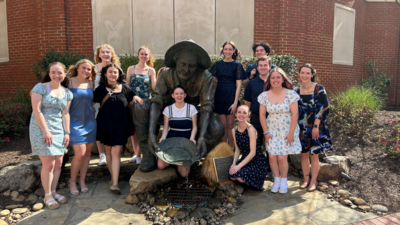How To Teach English as a Second Language

More than 10% of public-school students alone in the United States are English language learners, totaling about 5 million students, according to the National Center for Education Statistics. Throughout the world, there are 1.5 billion English language learners, experts said at a recent TESOL International Convention. Those numbers are only expected to rise.
As more and more people work to acquire English, we’ll need educators like you who know how to teach English as a second language. If you have been researching requirements to teach English as a second language or wondering how to teach English as a second language to adults and children alike, now is a great time to learn.
At Concordia University, Nebraska, we can help.
Become an ESL Teacher: Keep in Mind These Requirements To Teach English as a Second Language
If you’re hoping to obtain the credentials you need to become an ESL teacher, you’ve probably been researching programs and requirements to learn how to teach English as a second language. Here are a few to consider:
Obtain a bachelor’s degree or higher. To become an ESL teacher, schools, organizations and other institutions will typically require you to obtain at least a bachelor’s degree. If you already have a bachelor’s degree, you should consider earning a master’s. Although a graduate-level education isn’t necessarily one of the requirements to teach English as a second language, it could provide you with more job opportunities and help you qualify for higher-paying positions.
Hone your communication skills. To be an effective instructor and help your students learn and master English, you must have exceptional communication skills, including speaking, writing and listening.
Consider learning—or revisiting—another language. If you’re interested in how to teach English as a second language, learning or revisiting another language can help. Though your future students may speak a variety of first languages, knowing at least one of those languages could help you better connect with the students you teach. Not only would it give you another form of communication to use, but it will also deepen your empathy as a learner.
Sharpen your critical-thinking and problem-solving skills. Each of your future students will have a different learning style. This means that having excellent problem-solving skills is critical to help you adapt your teaching methods to reach all of your students, especially when they struggle to understand the course work.
Obtain a TESOL certification or ESL endorsement or complete a similar certification or program. Your employer may require a certificate or the completion of a specialized program. Requirements to teach English as a second language will vary by institution, so be sure to keep that in mind.
Educators Who Know How To Teach English as a Second Language are in Demand
In 2018, more than 5 million English language learners were attending public schools in the United States, totaling 10.2% of all students, according to the National Center for Education Statistics. That number is up about half a million students from 2010, and many anticipate the number to continue to rise.
In 2018, California reported the highest percentage of English language learners among its public-school students (19.4%), followed by Texas (18.7%) and New Mexico (15.8%), according to the Center.
Prepare now to meet that growing need in the future by learning how to teach English as a second language to adults and children.
Once you meet the requirements to teach English as a second language, you may qualify for a variety of jobs in the field, including:
Teaching English to adults
Teaching ESL classes online or through a community college
Teaching English as a missionary overseas
Working with refugees or immigrants through an organization, center or church
Directing or designing an ESL program through a school system
Designing ESL curriculum for school systems and government entities
The national average base salary for an ESL teacher in the U.S. is $50,953, according to Glassdoor.
Be a part of the next class of english educators.
Connect, Educate, Grow: Strategies To Help You Learn How To Teach English as a Second Language
In addition to completing an undergraduate or graduate degree and a specialized program, your education can include a wide variety of resources to help show you how to teach English as a second language to adults and children. From books to teach English as a second language to online games, here are just a few:
Raid your resources beyond your degree program. Your instructors and your course work will be your first and often best resources on this journey, but diving into books to teach English as a second language can help you hone the skills you need, too. Several books and blogs written by experts in the field, such as “The ESL/ELL Teacher’s Survival Guide” by Larry Ferlazzo and Katie Hull Sypnieski, make excellent resources to help you keep up to date on the latest strategies and practices after you complete your degree.
In addition to books to teach English as a second language, you will also find a host of blogs and other online resources written by experts to help you develop lesson plans and course work, including worksheets, activities and more. Many of these same authors have also written books to teach English as a second language.
Get in the game. From websites containing teacher resources to YouTube, a host of games await online to help show you how to teach English as a second language to adults and children. Playing games makes learning fun, while also including countless elements of language and communication that can benefit both you and your students.
Get to know your students. The students you will work with may be of all ages and backgrounds. To tailor your teaching methods to reach them all, you must be sensitive and aware of their cultural differences, learning styles and more to better reach students where they are.
For instance, Oregon ESL teacher Dr. Katie Toppel gets to know her students and their families in meaningful ways. She works to include specific details of students’ lives, such as pet names and sports, into her lessons. This makes for a more engaging learning environment and enables her to forge closer relationships with her students.Tap into tech. From EdTech apps to web widgets and beyond, options abound these days for digital resources for your classroom. Plug into them to help you continue to develop engaging curricula as you get a handle on how to teach English as a second language successfully.
Find the undergraduate or graduate program that’s right for you. No matter your industry, your future success in part will always be tied to your education. As you set out to learn how to teach English as a second language, be sure you select a degree program from an institution with values that align with your own. It will help you grow into the educator you dream to be while staying true to who you are.
Learn How To Teach English as a Second Language at Concordia Nebraska
If you have a bachelor’s degree and you’re interested in learning more about how to teach English as a second language to adults or children, earn the credentials you need at Concordia Nebraska.
Through our online master’s in reading and literacy degree program, you will build a solid foundation of knowledge and experience through online instruction and practical advice from educational professionals. You’ll also prepare to help students of all ages foster a love of reading and writing the English language.
Our M.Ed. in Literacy will enable you to focus your studies on your choice of two concentration areas:
Literacy with Reading Specialist Endorsement, a 36-hour program that will teach you the effective and innovative methods of helping students learn to read, write and more. You’ll also learn how to implement assessment tools and adapt instructional strategies.
Literacy with Reading Specialist and ESL Endorsement, a 51-hour program that includes the Reading Specialist Endorsement but also will give you the skills and knowledge you need should you wish to learn how to teach English as a second language. For this concentration, you’ll explore resources for adapting lesson plans to align with students’ needs while also incorporating and understanding a variety of cultural issues as part of instructional practice.
In addition to helping you learn how to teach English as a second language, our online M.Ed. in Literacy, accredited by the National Council for Accreditation of Teacher Education, will help you examine and build upon your teaching philosophy and approach to curriculum development through a lens of faith-based education practices.
At Concordia Nebraska, we are a Lutheran community that values the development of the whole person—academically, mentally and spiritually. As educators, we can help you learn to do the same.
Would you like to learn more about how Concordia Nebraska can help you reach your personal and professional goals? Request more information today.
Do you know someone who would love to earn their Christ-centered master's degree at Concordia University, Nebraska? Let us know, and we'll reach out to them!
Related Stories


